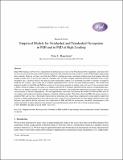| dc.contributor.author | Hagelstein, Peter L | |
| dc.date.accessioned | 2019-10-18T17:17:32Z | |
| dc.date.available | 2019-10-18T17:17:32Z | |
| dc.date.issued | 2015 | |
| dc.identifier.issn | 2227-3123 | |
| dc.identifier.uri | https://hdl.handle.net/1721.1/122635 | |
| dc.description.abstract | High D/Pd loading is known to be a requirement for producing excess heat in the Fleischmann–Pons experiment, and much work has in recent years been focused on electrochemical protocols and cathode processing in order to achieve D/Pd loadings approaching unity routinely. However, we know very little about PdD at a loading near unity, and almost nothing about what happens when the loading exceeds unity. It may be that when the octahedral sites are fully occupied, additional interstitial deuterium atoms occupy tetrahedral sites, a proposal which at this point has little experimental support. It is nevertheless possible to construct an empirical model for this scenario, and to make use of available experimental data to fit the associated model parameters. We worked with empirical models for both PdD and PdH that assume an O-site energy quadratic in loading, and an O-site to T-site excitation which
is either constant in loading, or else taken as an empirical function fit to estimates inferred from the analysis of experimental data.There are two empirical models, each with four or more free parameters; and insufficient experimental data from which to choose each parameter or function independently. We add supplementary constraints that presume the models for PdH and PdD must be very similar, which reduces the number of degrees of freedom within the models. This allows data from PdH to be used to construct a model for PdD, and vice versa. The models which result are interesting; they suggest these complicated systems might be understood based on a simple underlying picture; they indicate that there is more T-site occupation than has been appreciated previously in the literature; they indicate that the resistance ratio calibrations for PdH and PdD are inconsistent; and finally, measurements of the chemical potential at high loading have the potential to provide information about the O-site to T-site excitation energy. Keywords: Empirical models; Resistance ratio; Solubility of PdH and PdD at loading; Statistical mechanics model; Tetrahedral occupation | en_US |
| dc.publisher | International Society of Condensed Matter Nuclear Scientists (ISCMNS) | en_US |
| dc.relation.isversionof | www.iscmns.org/CMNS/JCMNS-Vol17.pdf | en_US |
| dc.rights | Article is made available in accordance with the publisher's policy and may be subject to US copyright law. Please refer to the publisher's site for terms of use. | en_US |
| dc.source | Prof. Hagelstein | en_US |
| dc.title | Empirical Models for Octahedral and Tetrahedral Occupation in PdH and in PdD at High Loading | en_US |
| dc.type | Article | en_US |
| dc.identifier.citation | Hagelstein, Peter L. "Empirical Models for Octahedral and Tetrahedral Occupation in PdH and in PdD at High Loading." Journal of Condensed Matter Nuclear Science 17 (2015): 35-66 © 2015 ISCMNS | en_US |
| dc.contributor.department | Massachusetts Institute of Technology. Department of Electrical Engineering and Computer Science | en_US |
| dc.relation.journal | Journal of Condensed Matter Nuclear Science | en_US |
| dc.eprint.version | Final published version | en_US |
| dc.type.uri | http://purl.org/eprint/type/JournalArticle | en_US |
| eprint.status | http://purl.org/eprint/status/PeerReviewed | en_US |
| dspace.date.submission | 2019-10-10T14:59:56Z | |
| mit.journal.volume | 17 | en_US |
